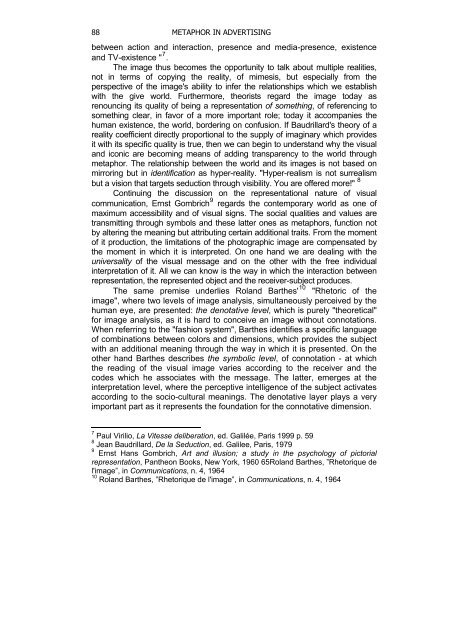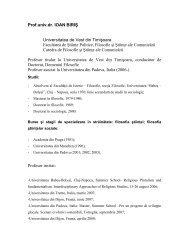VOL. IV (XXI) 2009 - Departamentul de Filosofie si Stiinte ale ...
VOL. IV (XXI) 2009 - Departamentul de Filosofie si Stiinte ale ...
VOL. IV (XXI) 2009 - Departamentul de Filosofie si Stiinte ale ...
Create successful ePaper yourself
Turn your PDF publications into a flip-book with our unique Google optimized e-Paper software.
88 METAPHOR IN ADVERTISING<br />
between action and interaction, presence and media-presence, existence<br />
and TV-existence " 7 .<br />
The image thus becomes the opportunity to talk about multiple realities,<br />
not in terms of copying the reality, of mime<strong>si</strong>s, but especially from the<br />
perspective of the image's ability to infer the relationships which we establish<br />
with the give world. Furthermore, theorists regard the image today as<br />
renouncing its quality of being a representation of something, of referencing to<br />
something clear, in favor of a more important role; today it accompanies the<br />
human existence, the world, bor<strong>de</strong>ring on confu<strong>si</strong>on. If Baudrillard's theory of a<br />
reality coefficient directly proportional to the supply of imaginary which provi<strong>de</strong>s<br />
it with its specific quality is true, then we can begin to un<strong>de</strong>rstand why the visual<br />
and iconic are becoming means of adding transparency to the world through<br />
metaphor. The relationship between the world and its images is not based on<br />
mirroring but in i<strong>de</strong>ntification as hyper-reality. "Hyper-realism is not surrealism<br />
but a vi<strong>si</strong>on that targets seduction through vi<strong>si</strong>bility. You are offered more!" 8<br />
Continuing the discus<strong>si</strong>on on the representational nature of visual<br />
communication, Ernst Gombrich 9 regards the contemporary world as one of<br />
maximum acces<strong>si</strong>bility and of visual <strong>si</strong>gns. The social qualities and values are<br />
transmitting through symbols and these latter ones as metaphors, function not<br />
by altering the meaning but attributing certain additional traits. From the moment<br />
of it production, the limitations of the photographic image are compensated by<br />
the moment in which it is interpreted. On one hand we are <strong>de</strong>aling with the<br />
universality of the visual message and on the other with the free individual<br />
interpretation of it. All we can know is the way in which the interaction between<br />
representation, the represented object and the receiver-subject produces.<br />
The same premise un<strong>de</strong>rlies Roland Barthes' 10 "Rhetoric of the<br />
image", where two levels of image analy<strong>si</strong>s, <strong>si</strong>multaneously perceived by the<br />
human eye, are presented: the <strong>de</strong>notative level, which is purely "theoretical"<br />
for image analy<strong>si</strong>s, as it is hard to conceive an image without connotations.<br />
When referring to the "fashion system", Barthes i<strong>de</strong>ntifies a specific language<br />
of combinations between colors and dimen<strong>si</strong>ons, which provi<strong>de</strong>s the subject<br />
with an additional meaning through the way in which it is presented. On the<br />
other hand Barthes <strong>de</strong>scribes the symbolic level, of connotation - at which<br />
the reading of the visual image varies according to the receiver and the<br />
co<strong>de</strong>s which he associates with the message. The latter, emerges at the<br />
interpretation level, where the perceptive intelligence of the subject activates<br />
according to the socio-cultural meanings. The <strong>de</strong>notative layer plays a very<br />
important part as it represents the foundation for the connotative dimen<strong>si</strong>on.<br />
7 Paul Virilio, La Vitesse <strong>de</strong>liberation, ed. Galilée, Paris 1999 p. 59<br />
8 Jean Baudrillard, De la Seduction, ed. Galilee, Paris, 1979<br />
9 Ernst Hans Gombrich, Art and illu<strong>si</strong>on; a study in the psychology of pictorial<br />
representation, Pantheon Books, New York, 1960 65Roland Barthes, ”Rhetorique <strong>de</strong><br />
l'image”, in Communications, n. 4, 1964<br />
10 Roland Barthes, ”Rhetorique <strong>de</strong> l'image”, in Communications, n. 4, 1964




